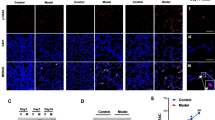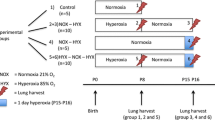Abstract
Breathing high concentrations of oxygen (hyperoxia) causes lung injury and is associated with lung diseases such as bronchopulmonary dysplasia (BPD), respiratory distress syndrome and persistent pulmonary hypertension of the newborns. Hyperoxia (95–100 %O2) causes DNA damage and growth arrest of lung cells and consequently cells die by apoptosis or necrosis. Although supplemental oxygen therapy is clinically important, the level and duration of hyperoxic exposure that would allow lung cells to reenter the cell cycle remains unclear. We hypothesized that cells exposed to lower concentrations of hyperoxia will retain the capacity to enter cell cycle when recovered in room air. We employed varying concentrations of oxygen (21–95 %) to determine the response of lung cells to hyperoxia. Our results indicate that cells were growth arrested and failed to reenter the cell cycle when exposed to greater than 60 % oxygen. Cell cycle checkpoint proteins were increased in a biphasic manner, increasing until 70 % oxygen, but declined in greater than 90 % oxygen. Microarray analysis shows that there is significant decrease in the abundance of Cdks 6-8 and retinoblastoma protein (Rb), p107 and p130 in exposure to 90 % oxygen for 48 h. We further tested the effect of clinically relevant as needed oxygen [(pro-re-nata (prn)] in premature infant (125-days and 140-days) baboon model of BPD. The microarray results show that 6 or 14d PRN oxygen-exposed animals had induced expression of chromosomal maintenance genes (MCMs), genes related to anti-inflammation, proliferation, and differentiation.







Similar content being viewed by others
Abbreviations
- MCM4:
-
Minichromosome maintenance deficient 4
- MCM6:
-
Minichromosome maintenance deficient 6
- TIMP3:
-
Tissue inhibitor of metalloproteinase 3
- E2F4:
-
E2F Transcription factor 4
- UBC:
-
Ubiquitin C
- Cyd3:
-
Cyclin D3
- P19A:
-
S-phase kinase 1A
- P16:
-
Cyclin-dependent kinase inhibitor 2A, p16INK4
References
Schober P, Schwarte LA (2012) From system to organ to cell: oxygenation and perfusion measurement in anesthesia and critical care. J Clin Monit Comput 26:255–265. doi:10.1007/s10877-012-9350-4
Das KC, Guo XL, White CW (1999) Induction of thioredoxin and thioredoxin reductase gene expression in lungs of newborn primates by oxygen. Am J Physiol 276:L530–L539
Das KC, Pahl PM, Guo XL, White CW (2001) Induction of peroxiredoxin gene expression by oxygen in lungs of newborn primates. Am J Respir Cell Mol Biol 25:226–232
Das KC, Ravi D (2004) Altered expression of cyclins and cdks in premature infant baboon model of bronchopulmonary dysplasia. Antioxid Redox Signal 6:117–127
Das KC, Ravi D, Holland W (2004) Increased apoptosis and expression of p21 and p53 in premature infant baboon model of bronchopulmonary dysplasia. Antioxid Redox Signal 6:109–116
Coalson JJ, Kuehl TJ, Escobedo MB, Hilliard JL, Smith F, Meredith K, Null DM Jr, Walsh W, Johnson D, Robotham JL (1982) A baboon model of bronchopulmonary dysplasia. II. Pathologic features. Exp Mol Pathol 37:335–350
Coalson JJ, Winter VT, Gerstmann DR, Idell S, King RJ, Delemos RA (1992) Pathophysiologic, morphometric, and biochemical studies of the premature baboon with bronchopulmonary dysplasia. Am Rev Respir Dis 145:872–881
Freeman BA, Crapo JD (1981) Hyperoxia increases oxygen radical production in rat lungs and lung mitochondria. J Biol Chem 256:10986–10992
Horowitz S (1999) Pathways to cell death in hyperoxia. Chest 116:64S–67S
Wikenheiser-Brokamp KA (2004) Rb family proteins differentially regulate distinct cell lineages during epithelial development. Development 131:4299–4310. doi:10.1242/dev.01232
Das KC, Dashnamoorthy R (2004) Hyperoxia activates the ATR-Chk1 pathway and phosphorylates p53 at multiple sites. Am J Physiol Lung Cell Mol Physiol 286:L87–L97
Kulkarni A, Das KC (2008) Differential roles of ATR and ATM in p53, Chk1, and histone H2AX phosphorylation in response to hyperoxia: ATR-dependent ATM activation. Am J Physiol Lung Cell Mol Physiol 294:L998–L1006
Kazzaz JA, Horowitz S, Li Y, Mantell LL (1999) Hyperoxia in cell culture. A non-apoptotic programmed cell death. Ann N Y Acad Sci 887:164–170
Kazzaz JA, Xu J, Palaia TA, Mantell L, Fein AM, Horowitz S (1996) Cellular oxygen toxicity. Oxidant injury without apoptosis. J Biol Chem 271:15182–15186
Das KC, Guo XL, White CW (1999) Hyperoxia induces thioredoxin and thioredoxin reductase gene expression in lungs of premature baboons with respiratory distress and bronchopulmonary dysplasia. Chest 116:101S
Ahmad S, White CW, Chang LY, Schneider BK, Allen CB (2001) Glutamine protects mitochondrial structure and function in oxygen toxicity. Am J Physiol Lung Cell Mol Physiol 280:L779–L791
Allen CB, White CW (1998) Glucose modulates cell death due to normobaric hyperoxia by maintaining cellular ATP. Am J Physiol 274:L159–L164
Budinger GR, Tso M, McClintock DS, Dean DA, Sznajder JI, Chandel NS (2002) Hyperoxia-induced apoptosis does not require mitochondrial reactive oxygen species and is regulated by Bcl-2 proteins. J Biol Chem 277:15654–15660. doi:10.1074/jbc.M109317200 M109317200 [pii]
Das KC (2013) Hyperoxia decreases glycolytic capacity, glycolytic reserve and oxidative phosphorylation in MLE-12 Cells and inhibits complex I and II function, but not complex IV in isolated mouse lung mitochondria. PLoS ONE 8:e73358. doi:10.1371/journal.pone.0073358
Gardner PR, Nguyen DD, White CW (1994) Aconitase is a sensitive and critical target of oxygen poisoning in cultured mammalian cells and in rat lungs. Proc Natl Acad Sci U S A 91:12248–12252
McGrath-Morrow SA, Stahl J (2001) Growth arrest in A549 cells during hyperoxic stress is associated with decreased cyclin B1 and increased p21(Waf1/Cip1/Sdi1) levels. Biochim Biophys Acta 1538:90–97
Innocente SA, Abrahamson JL, Cogswell JP, Lee JM (1999) p53 regulates a G2 checkpoint through cyclin B1. Proc Natl Acad Sci U S A 96:2147–2152
Morgan DO (1995) Principles of CDK regulation. Nature 374:131–134
Chehab NH, Malikzay A, Stavridi ES, Halazonetis TD (1999) Phosphorylation of Ser-20 mediates stabilization of human p53 in response to DNA damage. Proc Natl Acad Sci U S A 96:13777–13782
Danielian PS, Bender Kim CF, Caron AM, Vasile E, Bronson RT, Lees JA (2007) E2f4 is required for normal development of the airway epithelium. Dev Biol 305:564–576. doi:10.1016/j.ydbio.2007.02.037
Bagley BN, Keane TM, Maklakova VI, Marshall JG, Lester RA, Cancel MM, Paulsen AR, Bendzick LE, Been RA, Kogan SC, Cormier RT, Kendziorski C, Adams DJ, Collier LS (2012) A dominantly acting murine allele of Mcm4 causes chromosomal abnormalities and promotes tumorigenesis. PLoS Genet 8:e1003034. doi:10.1371/journal.pgen.1003034
Ryu KY, Maehr R, Gilchrist CA, Long MA, Bouley DM, Mueller B, Ploegh HL, Kopito RR (2007) The mouse polyubiquitin gene UbC is essential for fetal liver development, cell-cycle progression and stress tolerance. EMBO J 26:2693–2706. doi:10.1038/sj.emboj.7601722
Vodermaier HC (2004) APC/C and SCF: controlling each other and the cell cycle. Curr Biol 14:R787–R796. doi:10.1016/j.cub.2004.09.020
Gill SE, Huizar I, Bench EM, Sussman SW, Wang Y, Khokha R, Parks WC (2010) Tissue inhibitor of metalloproteinases 3 regulates resolution of inflammation following acute lung injury. Am J Pathol 176:64–73. doi:10.2353/ajpath.2010.090158
Gill SE, Parks WC (2008) Metalloproteinases and their inhibitors: regulators of wound healing. Int J Biochem Cell Biol 40:1334–1347. doi:10.1016/j.biocel.2007.10.024
Acknowledgments
Research reported in this publication was supported by the National Heart, Lung And Blood Institute of the National Institutes of Health under Award Number R01HL 071558, HL1R01HL107885 and HL1R01HL109397. The content is solely the responsibility of the authors and does not necessarily represent the official view of the National Institutes of Health. We acknowledge the superb and dedicated assistance of numerous physician, nurses, technicians, and other personnel at the Bronchopulmonary Dysplasia (BPD) Resources Center (San Antonio, TX). Excellent technical assistance of Harish Muniyappa and Ravi Dashnamoorthy is acknowledged.
Author information
Authors and Affiliations
Corresponding author
Rights and permissions
About this article
Cite this article
Das, K.C., Wasnick, J.D. Biphasic response of checkpoint control proteins in hyperoxia: exposure to lower levels of oxygen induces genome maintenance genes in experimental baboon BPD. Mol Cell Biochem 395, 187–198 (2014). https://doi.org/10.1007/s11010-014-2124-1
Received:
Accepted:
Published:
Issue Date:
DOI: https://doi.org/10.1007/s11010-014-2124-1




